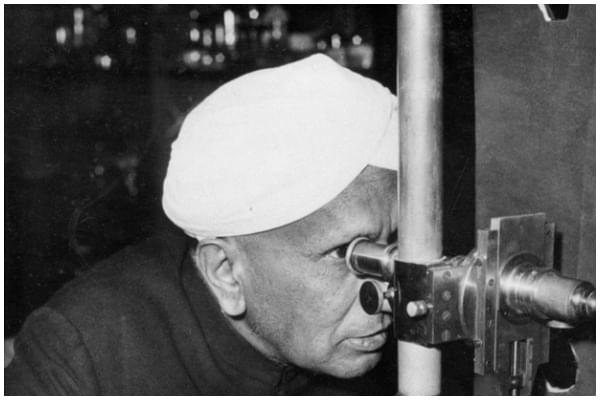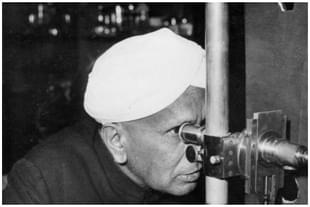From the archives
From The Archives: C V Raman’s Approach To Science
Swarajya Archives
Feb 28, 2018, 02:20 PM | Updated Nov 07, 2019, 01:29 PM IST
Save & read from anywhere!
Bookmark stories for easy access on any device or the Swarajya app.


By A. Ranganathan
Of all Modern Scientists, Professor C.V. Raman is the easiest to write about. For there has never been any half measure about his responses. Indeed whatever his theme, of scientific exposition, aesthetic experience or some inner struggle of the human spirit, there is the recognizable element of directness in his style. And this style is derived from his lifelong quest for beauty.
In his delightful book, A Mathematician’s Apology, G.H. Hardy observes that “a mathematician, like a painter or poet, is a maker of patterns- the mathematician’s patterns, like the painter’s or the poet’s, must be beautiful; the ideas like the colours or the words must fit together in a harmonious way.” Raman has been inspired by the aesthetic impulse in his scientific career. His scientific investigations on the colour of the sea and of ice in glaciers, in the plumage of birds and iridescent shells, the green colour of vegetation and the perception of colour, the structure of the diamond and the physical theory of musical instruments, can be perceived as an exquisite symphony of light, colour and form, sound, harmony, and rhythm.
Professor Raman’s recent convocation address at the Indian Institute of Technology was a breath of spring. He is alive to the beauty of the scenery. It is hardly surprising that he was attracted by “the wonderful old banyan trees, the well-laid out gardens and farms” in the Institute. Indeed it is an aesthetic experience to observe Raman in rapture as the mellow sunset and the soft breeze transfigure the quivering leaves and flowers of his own garden into a colourful panorama of visual perception. He has compared the scenic beauty of water in a landscape to the eyes in the human face as “it reflects the mood of the hour, being bright and gay when the sun shines, turning to dark and gloomy when the sky is overcast”.
Raman’s tribute to Nature as his “greatest teacher” unveils the vistas of his brilliant scientific career. His visit to Europe in 1921 marked a turning point in his career. During the voyage he observed the blue opalescence of the Mediterranean Sea, and it struck him that “the phenomenon owed its origin to the scattering of light by the molecules of the water”. In order to verify this explanation, he conducted a series of experiments on the scattering of light. These experiments ultimately resulted in the discovery of the Raman Effect which won for him the Nobel Prize for Physics in 1930.
Raman’s aesthetic quest leads us on to a discussion of scientific reference in modern literature, which paradoxically enough is less concerned with science than was literature in the previous ages. Aldous Huxley has explained it by shrewdly remarking that in this scientific age it is enough if science enters poetry by philosophic implication, but nevertheless stresses the case for science as a personal metaphysical concern of the poet. The man of letters and the scientist are equally concerned with what Huxley termed the need to “give a purer sense to the words of the tribe” at different levels of perception.
Sir Charles Snow, who concerned himself with the widening gap between science and the rest of our culture in his Rode lecture, sparked off an interesting controversy. Sir Charles did not make a plea for universal dilettantism, but for an end to the cold war between the “two cultures”, the sciences and the humanities. Gertrude Stein’s oft-quoted line, ‘A rose is a rose is a rose’ may be RNA, DNA, polypeptide chains of amino-acids, to the biological scientist. Similarly, Wordsworth’s blue sky might mean something different to the physicist: he would be interested in the blue colour as due to the scattering of the light from the sun by the particles in the atmosphere.
Sir Charles’ casual observation that literary men do not know such concepts as the Second Law of Thermodynamics, which to him, constituted the scientific equivalent of “Have you read a play by Shakespeare?” was characterized by F.R. Leavis in his polemical Richmond Lecture as a “cheap journalistic infelicity”. The irony of it lies in the fact that both Snow and Leavis missed the significance of entropy in referring to the Second Law of Thermodynamics. The entropy of a system is a measure of its degree of disorder, and human achievement itself is based on an aesthetic endeavour to release patterns, or negative entropy as the physicists term it. The release of patterns or negative entropy may range from Leavis’ unimaginative essays in Scrutiny to Einstein’s application of geometrical reasoning to gravitation.
“The most beautiful thing we can experience”, declared Einstein, “is the mysterious. It is the source of all true art and science”. This world of beauty represented by men like Einstein and Raman is different from the world of sputniks and astronauts. In fact the world of Raman is at the other end of the spectrum! When reflecting on Raman’s approach to science, one is reminded of G.M. Trevelyan’s words in assessing the personality of another great man: “He was an outstanding example of a type that has always attracted me: the specialist who has a wide outlook, broad knowledge and warm enthusiasm outside his own subject as well as in it, and more particularly, a man he was whose mind has been trained in the splendid discipline of science, but whose heart and eyes also take delight in the triumphs of art, in the history of man, in the beauties of nature. Such a man is about the best thing that our modern civilization can produce.” Raman is not only one of the foremost leaders of the heroic age of modern physics, but also an artist who has added a new dimension to the physiological world of perception in an era of specialization and “the two cultures”.
Selections from Swarajya's 40,000 pages of archives since 1956.





